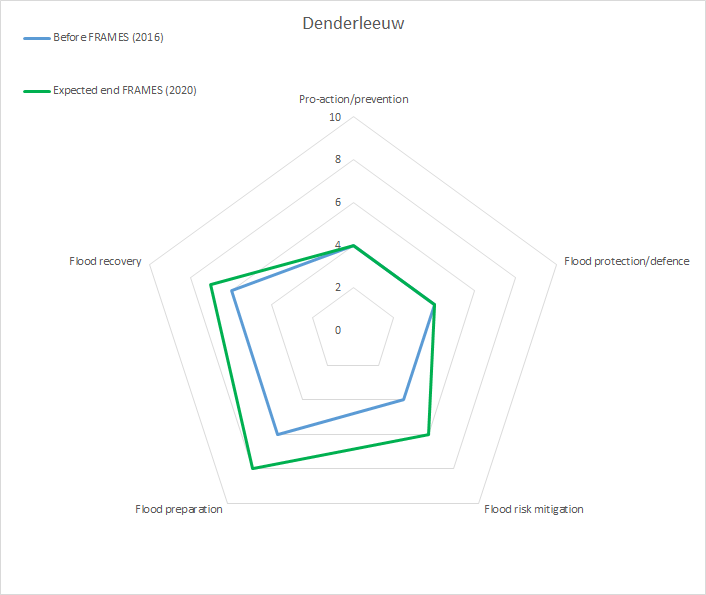Implementation process
By looking at the the activities, actors and methods or approaches used, this section will provide a better understanding of the implementation process of the MLS approach. We will describe the point of departure, who was involved (when, why and how) and what key decisions were made when and why.
Point of departure of FRM strategies
Figure 1: Initial and desired score to reach per layer in the Denderleeuw pilot (Baseline monitor, 2017)
To measure the impact of FRAMES on improving the flood resilience of pilot areas, communities and authorities both a baseline and final monitoring survey have been conducted. The surveys were completed by pilot managers in consultation with key pilot stakeholders. The baseline survey included questions about the actual situation in 2017 (before the project started) and expectations for 2020 (see figure 1). The final survey contained similar questions, but about the actual situation in 2020 and expected situation for 2025, five years after the pilot projects are finished. All the scores for both surveys along with and interpretation, be found in chapter 8 of the Transnational Monitoring and Evaluation Report.
Stakeholders involved
The primary stakeholders are citizens and companies located in flood-prone zones (as defined by the flood risk maps). In addition, the following stakeholders are identified:
Public actors:
- Municipality of Denderleeuw
- Flemish spatial planning department (Department Omgeving)
- Water management agencies:
- The Flemish Waterways (De Vlaamse Waterweg)
- VMM (Flanders Environment Agency)
- Province of East-Flanders
- Aquafin
- Public secondary school of Denderleeuw
- Natuurpunt
Citizens:
- The students of the secondary school
- Pupils of primary school
Private actors:
Main activities
At the start of the project, the Province of East Flanders and the UGhent developed a participation strategy including a stakeholder analysis whom they wanted to reach, and how to involve them. There were three target groups: flood-prone citizens (1), wider community (2) and local governments (3).
1. Flood prone citizens
Community resilience workshops were organised as a mean to involve flood-prone citizens, to raise awareness, activate them, change their attitude towards what they can do themselves, find citizens that are interested to become part of working groups to work on a specific product / topic.
First, door-to-door visits were done with flood-prone citizens in Denderleeuw:
- To get a good idea of the profile of the people and spark their interest in participating in the community resilience workshop
- Further community resilience workshops did not take place due to a lack of authorization from the local authorities. Denderleeuw was thus put on the side and the community resilience workshops were exclusively organised in Ninove.
2. Wider community
A school program was developed by the UGhent for children from 10 to 18 years old to raise awareness. Two schools were contacted in Denderleeuw in June 2018, one primary and one secondary school. The program was conducted in the primary school in October 2018 and the program for the secondary took place in April and May, 2019. Further information sessions with teachers and parents were organised in June and in the first semester of the year 2019-2020.
3. Local authorities
In the beginning of the pilot, contacts were established with several local governments (Ninove, Denderleeuw, Liedekerke). The FRAMES project was presented to find out who is interested in participating, where to carry out the community resilience workshops, and so on. The Province stayed away from asking too much engagement of the local governments, because they knew that they only have limited capacities. As a result, local governments have now a rather passive attitude in the FRAMES pilot.
Referenties
- Transnational Monitor and Evaluation report FRAMES, FRAMES, FRAMES, 8 juni 2020.
- Monitoring survey 13 Denderleeuw, Mees, H. and B. Tempels, 9 januari 2019.

